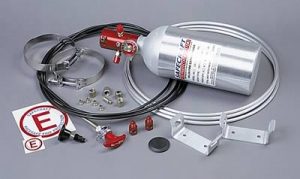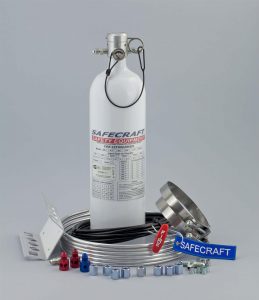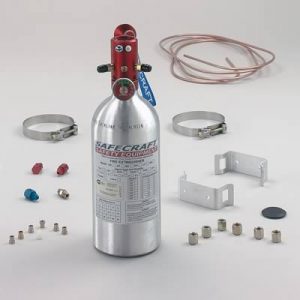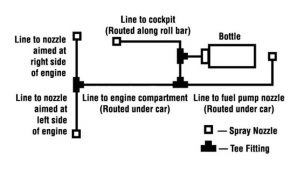 We won’t say fires are common at the race track, but they do happen. A few of us have already witnessed motorsports fires this year, so we’ve decided to revisit the topic of onboard fire suppression systems.
We won’t say fires are common at the race track, but they do happen. A few of us have already witnessed motorsports fires this year, so we’ve decided to revisit the topic of onboard fire suppression systems.
Is an onboard suppression system an added expense? Yes.
Can you really afford NOT to have one in your car? That’s ultimately up to you and your race sanctioning body, but there’s no doubt a fire suppression system can save your life when the unexpected happens. Many circle track, drag racing, and road racing sanctioning bodies require a fire suppression system, and we’d always recommend you have one if you’re running something faster than a 14-second bracket car.
To choose the right fire suppression system, it comes down to your sanctioning body rules, chemical agent, and how involved you’d like to get with the setup. Using Safecraft’s most popular fire suppression systems as examples, we’ll show you how to pick the right fire suppression system and setup for your vehicle.
Safecraft LT vs. RS Systems
Safecraft is a leading manufacturer of vehicle fire suppression systems and offers an array of options. The folks at Summit Racing offer Safecraft’s two most popular motorsports fire suppression systems: the LT and RS. Both systems are available for drag racing and circle track applications. The drag racing systems come with steel discharge lines as required by the major sanctioning bodies. The circle track kits come with aluminum lines.
The LT and RS systems share some common traits. Both use a lightweight, DOT-approved fire extinguisher with a unique swivel head that allows the activation portion of the discharge head to be rotated for easy plumbing and cable connection.
 Safecraft LT Fire Suppression System
Safecraft LT Fire Suppression System
This system features Safecraft’s lighweight LT fire extinguisher, which has a very compact discharge head to give it a smaller overall size. The discharge head has two separate discharge ports, allowing you to run separate lines to the driver and engine. It’s available with either Halon or DuPont FE36 extinguishing agent. Rule book requirements, temperature considerations, and the installation would determine which agent should be used (more on that in a bit).
Standard LT fire suppression kits include a charged extinguisher, aluminum mount bracket, aircraft “T” bar clamps, 10 feet of discharge line, three spray nozzles with fittings, and the activation method you choose. Again, key features of the Safecraft LT fire suppression system are:
- Lightweight DOT approved cylinder and head combination.
- Almost 1 pound lighter than other systems.
- Unique Safecraft swivel head design for easier installation.
- Dual discharge outlets, driver and engine.
- SFI 17.1 certified, depending on agent
- Available with Halon, Novec 1230, or DuPont FE36 agent
 Safecraft RS Fire Suppression System
Safecraft RS Fire Suppression System
Safecraft’s RS fire suppression system is a step up from the LT system and is a great choice for all types of racing, depending on the agent you use. The RS system is capable of accepting up to three separate discharge lines so you can aim the nozzles at the driver, engine, and fuel cell for added fire control. In addition, the RS system can be activated by a combination of methods (example, 2 pull cables) without changing the extinguisher head.
The Safecraft RS fire suppression system includes a charged extinguisher, aluminum mount brackets, aircraft “T” bar clamps, 10 feet of discharge line, three spray nozzles and fittings, and the activation method you choose. Key features of this system include:
- Universal 5-way operating head machined from billet aluminum.
- Activation by pull cable, push cable, push knob, or a combination of any of these.
- Activation method can be changed without purchasing a new extinguisher.
- Swivel discharge head for ease of plumbing and cable connections.
- High pressure DOT approved cylinders in 5, 10, and 20 pound sizes.
- Three discharge ports for driver, fuel cell, and engine.
- SFI 17.1 certified, depending on the agent
- Available with Halon or DuPont FE36 agent
Fire System Agent Overview
Once you’ve chosen the type of system you want, you’ve got a few more critical choices to make. Anytime you’re picking a fire suppression system, you need to make sure the extinguishing agent used is compatible with your sanctioning body’s rules. Onboard suppression systems typically use one of the following chemical agents to extinguish fire: Halon, Dupont FE36, Novec 1230, or AFFF.
Aqueous Film Forming Foam (AFFF) is popular in Europe and is a water-based solution that is discharged as a soapy solution. It does a great job of quenching fires, but it also leaves a bigger mess than other agents.
Safecraft sticks with Halon, Novec 1230, or Dupont FE36 agents.
Halon is stored as a liquid under pressure and discharged as a combination of liquid and gas that flows around obstructions to smother the flame and cool the fire to reduce re-ignition. It is a clear gas, so it can fill the cockpit and suppress a fire without hindering your ability to find your way out. It also won’t damage expensive electronics and doesn’t require cleanup under normal circumstances.
Halon has been around (seemingly) forever, but is no longer SFI approved. Depending on the specific class, many sanctioning bodies require a fire extinguishing system that meets SFI 17.1. Consult the rules before opting to use any system with Halon.
Dupont FE36 is DuPont’s SFI-approved replacement for Halon. Unlike Halon, it doesn’t contain any ozone-depleting chemicals and has a lower toxicity than Halon. FE36 offers similar performance to traditional Halon, but it takes quite a bit more FE36 to do the job. For that reason, you may need to use a larger extinguisher bottle compared to a Halon system. Still, many manufacturers are moving to the FE36 agent, which is also friendly to electronics.
Novec 1230 is 3M’s SFI-approved replacement for Halon. Like FE36, it is more environmentally friendly than Halon and is safe to use around your expensive race electronics.
Before you choose your chemical agent, consult your rule book.
Mounting Considerations
You’ll also need to consider the ideal mounting situation for your race setup. For example, which activation would work best for you. Safecraft offers its LT and RS fire suppression systems with a variety of options:
- Push/pull-cable: In this setup, a cable is used to set off the extinguisher. Most systems use a safety pin to prevent accidental activation before installation. The advantage to this setup is its comparatively inexpensive but allows you to mount the push/pull-cable handle where it’s quick and easy to reach.
- Push-knob: In this design, the push-knob is mounted right on the extinguisher. These systems also use a safety pin to prevent undesired activation, but don’t give you the mounting flexibility of cable-activated systems. The extinguisher itself must be mounted near the driver.
- Electrical: These systems use a triggering switch and an activation box to electronically work the fire extinguisher.
Keep in mind, sanctioning bodies also have rules regarding how cables are installed. Consult your rules to ensure you adhere to the necessary standards.
Bottle size is another important consideration. Your sanctioning body may have rules governing the minimum size of the fire bottle, so you’ll want to consult your rule book. However, depending on the bottle size, weight distribution may come into play and could potentially effect the performance of your race vehicle. Plan accordingly when selecting a location for your bottle or bottles.
 Finally, you’ll need to figure out optimal discharge nozzle placement. Again, the Safecraft RS fire suppression system gives you the most comprehensive coverage with its three discharge nozzles. You can aim one each at the driver, engine, and fuel cell. For a little bit less money, you can opt for the two-nozzle configuration of the LT system. Again, the driver is most important, so aim the first nozzle at the driver’s area and the second at the engine. You can always add more discharge lines later by using T-fittings on your existing lines (see diagram above left). Keep in mind, though, additional discharge lines will require additional fire suppressant.
Finally, you’ll need to figure out optimal discharge nozzle placement. Again, the Safecraft RS fire suppression system gives you the most comprehensive coverage with its three discharge nozzles. You can aim one each at the driver, engine, and fuel cell. For a little bit less money, you can opt for the two-nozzle configuration of the LT system. Again, the driver is most important, so aim the first nozzle at the driver’s area and the second at the engine. You can always add more discharge lines later by using T-fittings on your existing lines (see diagram above left). Keep in mind, though, additional discharge lines will require additional fire suppressant.
Obviously, you don’t have to opt for one of the Safecraft systems outlined here; however, we’d advise you to not skimp on a lesser brand. If you do opt for a different system, you can apply some of the lessons covered here to ensure you get the right setup for your needs.

Its absolutely mind blowing how technology has advanced to create these lightweight fire suppression systems for high powered cars.
DO YOU HAVE A SYSTEM SPECED OUT FOR SPRINT CARS?
Almost all systems use a syphon tube inside the bottle regardless of agent, hence why the bottle needs to be mounted in a specific way, kindoff pointless if the vehicle ends up on its roof or side? Got any solution to that?